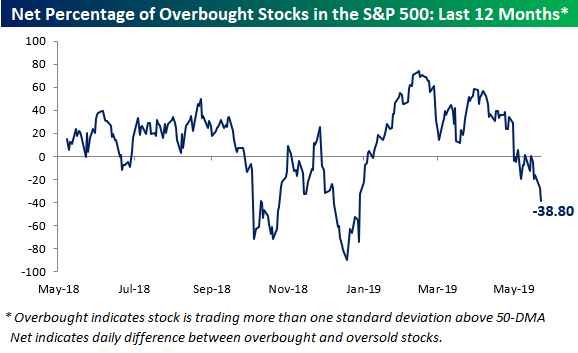U.S. markets were closed on Monday for the Memorial Day holiday, but the selling pressure on stocks did not take a break this week.
There was little progress in trade talks between the U.S. and China. In fact, President Trump declared trade war in a new theater on Thursday, proposing a 5% tariff on all goods imported from Mexico, beginning June 10.
This continued global economic uncertainty sent investors looking for safety in bonds. Short-term rates moved so low on Wednesday that the yield on 3-month bills T-bills was 14 basis points below 10-year notes, which is a level of inversion that hasn’t been seen since the Financial Crisis.
As a reminder, bond investors are not always right, but an inverted yield curve is generally viewed as a “canary in the coalmine” that a recession could materialize in the next year or so.
Even so, there are plenty of reasons to remain constructive on select investment areas. For example, dividend stocks become more attractive as Treasury yields move back down. In addition, the first-quarter GDP report was revised down to still-impressive 3.1% growth on Thursday.
Plus, there’s always the notion that investors have an FOMC put option in their back pocket. Fed funds futures are pricing in an 85% possibility of an interest rate cut by the end of the year, compared with a 66% chance a month ago.
The following chart from the Bespoke Investment Group also gets the Contrarian investor in me excited. While timing the market is a tricky game for any investor, we appear to reaching an oversold condition where it again makes sense to put cash to work in quality companies.

Source: Bespoke Investment Group
Apparel and Retail Names Feel Trade Tension
However, it remains a case of “buyer beware” in the retail sector. Investors have become increasingly skittish about this space, especially with apparel-related names, as consumer goods would likely be in the crosshairs if the U.S. enacts tariffs on another $300 billion basket of Chinese products in June.
PVH (PVH) helped confirm some of those fears this week. The stock fell 14% a day after cutting guidance because of a stronger U.S. dollar and lower retail sales in China. Abercrombie & Fitch (ANF) and Canada Goose (GOOS) fared even worse, dropping 26% and 30% respectively in a single session, after disappointing investors with their own forward outlooks.
Eagerly Looking to Next Week and a New Month
Looking ahead to next week, Kraft Heinz (KHC) and Salesforce.com (CRM) highlight a relatively light earnings calendar. On the economic front, all eyes will be on the May jobs report next Friday. A good number could go a long way to dispel the rumors of pending doom-and-gloom that have been hanging over stocks the past couple of weeks.
Markets have a short memory and a “what have you done for me lately?” attitude, when it comes to performance. Most investors have already forgotten the white-hot start we saw with U.S. stocks in the first four months of 2019 and are just happy to close the books on the month of May.
Whether you’re in the Bull camp or siding with the Bears for June and the rest of the year, one investing trend that never goes out of style is buying companies with above-average growth. Sales and earnings growth is one thing, but when management consistently increases a company’s dividend, investors have an opportunity to compound investment returns over time, without the worry of short-term trading volatility.
I’m happy to say that my colleague Brett Owens has devised a strategy which accomplishes just that. It takes the guesswork out of trying to time the market, by focusing on stocks that deliver both growth and income on a consistent basis.
Through his Hidden Yields portfolio, Brett has built a portfolio that’s generated 16.3% annual returns since inception. That’s enough to more than double your money in five years.
This should be welcome news to anyone that’s already retired or is looking to build a nest egg with passive income, without worrying about the next recession or bear market.
Today, we want to share seven of Brett’s top stocks. These names should generate double-digit annual returns, regardless of the direction of the broader market.
Now, these won’t be the fastest-growing companies in the market. The cautionary tale of Canada Goose this week is a reminder what happens when a firm with a “can’t miss” fashion trend flies too close to the sun.
Neither will they be the highest yielding stocks in the market. That notion will cause you to become ensnared in too many value traps.
Rather, balancing the two and generating total return is the name of the game with Hidden Yields. Brett scours the market for companies with average-size dividends today, but a history of consistently raising the payout.
You need to generate steady earnings and cash flow to accomplish this. Cash that is also often returned to investors through share repurchases.
Add in a stock that’s down from its recent highs, or better yet, valued at a discount to its growth rate, then you’re on the path to discovering the upside potential that Brett will help you find with Hidden Yields.
